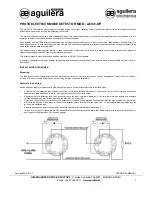
Mercedes-Benz Body & Equipment Guideline for Metris - BM 447, Version November 27, 2015.
!
Please observe the revision notes compared to 09/18/2015 ! Only print out complete sections of the current version!
87
7.6 Attachments
7 Modifications to the basic vehicle
The proper application of these measures will ensure
that the basic vehicle remains free of rust for many
years.
•
Bolt on the vehicle equipment through the vehicle
floor
•
The maximum tightening torque for the bolts is
25 Nm
•
The fastening points for the vehicle equipment must
be checked and retightened if necessary at regu-
lar intervals, every 5,000 km at the latest or after
unusual loading (emergency braking).
Mounting floor
The base should be a mounting floor, which is bolted
on through the existing threaded holes in the vehicle
floor. It is also permissible to attach it using a suitable
adhesive over its entire area or to combine the two
aforementioned fastening types. We recommend anti-
slip, pressure-resistant, oil/water/acid-resistant floors
for shelving or workshop installations. The quality of the
mounting floor should be at least equal to the wooden
floor supplied ex-factory.
Bolting to the floor
There are various methods for bolting the shelving to
the floor depending on the requirements:
•
Bolting it to a special mounting floor, which is
bonded to the vehicle floor over its entire area or
bolted to the existing attachment points of the
vehicle floor or which combines the two aforemen-
tioned fastening types.
•
Drilling through the body floor so that the structure
is bolted on through both the mounting floor and
the vehicle floor panel.
•
High-rib/low-rib connection:
Spacer sleeves bushings are required when con-
necting to a low rib.
Bolting through the floor panel
Connection on high and low rib
Existing attachment points in body floor and belt
rail
1 Attachment of sidewall tie-down rail to belt rail
(code V42)
2 Tie-down eye attachment
3 Load retainer rail system attachment (code VV2)
















































